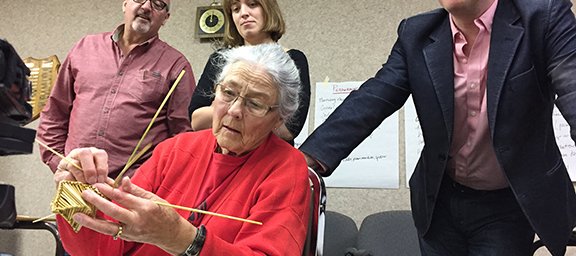
Discovering Your Unique Sense of Place
Rumour has it that Dale Jarvis likes to start fights between “little old ladies.”
Jarvis, who is from Newfoundland, was in Saskatchewan this past September to co-facilitate with Heritage Saskatchewan’s Intangible Cultural Heritage Development Officer, Kristin Catherwood, several Intangible Cultural Heritage (ICH) workshops across the province. Jarvis works at the ICH Development Officer for the province of Newfoundland and Labrador, and it is his job (and passion) to help communities safeguard traditional culture.
These workshops sometime would erupt in passionate, but friendly, debate between attendees (some of which are “little old ladies”) on topics ranging from local slang definitions, to traditional recipes, to community landmarks, and everything in between.
Jarvis and Catherwood traveled to Swift Current, Indian Head and Wanuskewin to meet up with members from local museums, town administrators and others who are interested in learning about the tools that will help them discover and celebrate their community’s unique stories and traditions.
On behalf of Engage, Shaunna Grandish, SaskCulture, sat down with Jarvis and Catherwood during a break in the Indian Head workshop to chat about ICH, what makes Saskatchewan culture unique and the importance of its preservation.
Engage: Hello! It’s nice to have you back in Saskatchewan Dale [Jarvis]. What has been your experience in this province so far?
Dale Jarvis: “It’s been great! This isn’t my first rodeo as this isn’t my first time in Saskatchewan. I’m struck in many ways of the similarities between what happens here and what happens in Newfoundland. Newfoundland has been a place that has been dependant on one industry [fishing] for a very long time, and that industry has suffered decline. There are lots of rural communities that are struggling to find new ways on how to live in those places. However, a strong sense of community and heritage is seeing those communities through difficult times. And I see that here in Saskatchewan.”
Engage: Please share how you describe Intangible Cultural Heritage?
Jarvis: “Intangible Cultural Heritage (ICH) is our living heritage – it’s the things that aren’t necessarily tangible artifacts, like buildings, but are part of those things that make us who we are: it’s our cultural expressions; it’s our dances; it’s our stories; it’s our skills and knowledge; it’s how we live on the land; and how we create. It’s all these things together that give us a sense of our own cultural identity.”
"I think all of our heritage is important because it is what defines us; it says who we are."
Engage: Why is it important to preserve our ICH?
Jarvis: “I think all of our heritage is important because it is what defines us; it says who we are. Sometimes our traditional knowledge gives us really important lessons because these skills can serve practical purposes today. As well, it’s tied to things like tourism, development, craft development, business development and sustainability in our communities. There’s all kinds of good reasons to get involved with ICH.”
Kristin Catherwood: “Heritage literally defines who we are, and there’s a lot of literature that shows the connections between heritage and well-being for ourselves and our community. So we are really interested in exploring that connection between community wellbeing and cultural heritage and how they are completely interwoven.”
| From the UNESCO Convention on the Safeguarding of Intangible Cultural Heritage, “Intangible cultural heritage includes: oral traditions, performing arts, social practices, rituals, festive events, knowledge and practices concerning nature and the universe, or the knowledge and skills to produce traditional crafts.” |
Engage: Are communities here in Saskatchewan starting to grasp to concept of ICH?
Catherwood: “I think that it’s starting to click in with communities here. I sometimes have to remind myself that we are just beginning this work and it’s only been about two years that I’ve been actively going out to Saskatchewan communities and talking about these concepts. That being said, I know now there’s people in the province who are using the term Intangible Cultural Heritage who weren’t using it a few years ago. I’ve seen communities where every workshop I go to where I explain what ICH is and it clicks with people – ‘I know what that is!’ they say. We all retain this ICH, so this happens in every workshop that I do.
On a whole provincial level, I am seeing things really moving forward and there’s exciting work with these concepts that have grown out of workshops where they went from not knowing what ICH is, to now working it into their projects and cultural plans for their communities. It’s definitely happening and I’m excited as time goes on as it’s going to expand around the province.”
Engage: What are some examples of ICH in Saskatchewan?
Jarvis: “We’re here in Indian Head today and there was a demonstration by Donna Thompson with wheat straw weaving. It’s tied to a whole other series of traditions – agricultural traditions, knowledge that people have about growing particular crops, knowledge about the seasons and transitions within the year, and harvest time. Those are all examples of ICH -- the body of knowledge around agricultural heritage and work and traditions.”
Catherwood: “I really like to connect people with their local place, and I always start workshops with asking people ‘where are you from?’, ‘why’s your place called that name?’ It starts a conversation about place names that we use to describe our everyday environment. We’ve been talking in this workshop, in Indian Head, of words that are very familiar to us, but Dale wasn’t familiar with -- like ‘slough’, ‘bluff’ and ‘coulee’. These words are examples of ICH. They are very localized to our specific geographical area, but we take them for granted.”
Jarvis: “One of the things I try to show communities is that they have knowledge that is special to them and that people outside their community don’t necessary have this knowledge. I love going to a new place and learning about new traditions, new hidden histories that exist. Every time I do a workshop, there’s always something new to learn about a community, and I love elevating the discussion around those things and having people talk about the things that make their community and town special.” [This is where senior women get into animated discussions, and sometimes disagreements, about the way things are cooked, preserved, etc.]


Engage: Do you see your own community in a new light from doing these workshops?
Catherwood: “This journey is about discovering things that were always there and we never thought of. Talking about ICH and heritage to communities can really shift the perspective about who we are, what place we occupy in the world, and what that place means to us. I’m constantly learning and renegotiating my story of who I am and where I’m from, and realizing the larger story that I’m part of. Yes, I do constantly learn about new things about myself, my community and my province.”
Engage: It sounds like these ICH workshops are a success.
Catherwood: “It’s great to have Dale here to have that outsider perspective on the province and to have his wealth of knowledge and expertise – it not only informs my work, but it also inspires all the people attending these workshops.
I really want to stress how exciting it is that Saskatchewan is starting to take the lead in ICH in Canada. Newfoundland has shown how successful ICH can be and I’m really glad that Heritage Saskatchewan has taken the lead on this and we are supported by SaskCulture, Museums Association of Saskatchewan, Saskatchewan History and Folklore Society, and other groups, that we are becoming trailblazers in this kind of work in Canada. It’s a really exciting time to be working in heritage in the province.”
Visit heritagesask.ca to learn more about Intangible Cultural Heritage.


 Engage - Volume 7, Issue 1, Fall/Winter 2016
Engage - Volume 7, Issue 1, Fall/Winter 2016